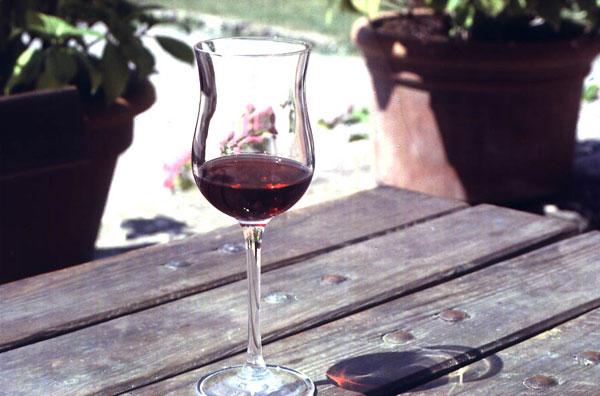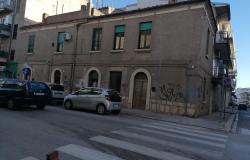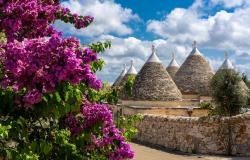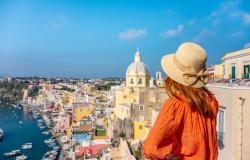Our stroll south of Rome takes in some of Italy’s best coastal scenery: high steep cliffs; volcanic cones – some dormant, some active; spectacular views both inland and coastal.
The dramatic change in the climate affects the terrain, the houses, the people and above all, the grapes. Until just 30 years ago, the south’s wine reputation was poor ‘vino da tavola’ – earthy, odd, treacly and tar-like. The grapes were unique, unpronounceable and derived from viticulture practiced from as far back as 1500 BC and influenced by the Greeks, Phoenicians, Egyptians, Spanish and Romans. Apart from Puglia, the terrain is hilly and mountainous, and soils mainly volcanic or granitic. It is the home of regular earthquakes and the live volcanoes of Vesuvius, Etna and Stromboli. The noon sun is uncompromising and there is a shortage of water. What chance for quality?
Wines described as ‘disagreeably rough’ by travellers in the 19th and early 20th centuries, were protected in the 1960s by vast EU subsidies that formed the famous wine lake of Europe. It was the base wine for vermouth; it was the blender for French or German wines weak in colour and alcoholic strength. Great vats of this wine were distilled into industrial alcohol.
The six regions produced 40-50% of Italy’s total of wine output, but only produced 7% of its quality wines. Surprisingly, white wines dominated in this very hot dry region.
But all that has changed in the past 15 years…
Calabria, Campania and Basilicata
These regions all have potential as yet to be unleashed.
Campania is the gateway to southern Italy. It is steeped in history and the Romans considered Falernum the most treasured wine of the Empire. The wine area on the coast as you approach Naples is now Falerno del Massico DOC. The best wine is a red made with the Aglianico grape introduced by the Greeks 2000 years ago.
South of Naples the two tiny islands of Ischia and Capri make small quantities of red, white and rosè for local consumption.
On the mainland, Mt Vesuvius with its volcanic, rich soils, dominates the area. On the bay side of the volcano, Vesuvio DOC is famous for its Lacryma Christi del Vesuvio wines. There are various explanations for the origin of this name ‘The Tears of Christ’. I prefer to believe the one where ancient villagers, on observing the occasional eruptions of lava streams flowing down the slopes through their vineyards, explained to youngsters that sometimes Christ is sad and this is Him crying. (Remember the proximity to the Pope in these areas).
Whilst strolling through Pompeii, 200 wine bars are still recognisable in the ruins. Eight bars stand in line outside the public baths to slake the enormous thirst of Pompeiians on leaving their hot rooms. Of the 32 villas discovered around the countryside near Vesuvius, we know that 29 of them produced wine (up to A.D.79 that is!).
On the eastern side of Vesuvius are the DOCs: Taurasi for reds, and Greco di Tufo and Fiano di Avellino for whites. Taurasi, as made by Antonio Mastroberardino in Avellino, is considered to be the Barolo of the South. Well worth searching for.
As we move south along the majestic coast from Sorrento to Amalfi then Salerno, it is the lemon and not the grape that dominates the hillsides. Every style of lemon liquoroso drink is available, but don’t expect wonders from the wines.
Calabria’s best known wine is Cirió on the Ionian coast, both red and white. Basilicata’s best is Aglianico del Vulture, a red that needs ageing. In both these regions in the villages, the local sweet wine can surprise you, but neither region produces anything vinously memorable. Enjoy the stunning scenery instead.
Puglia
The region of the heel, Puglia, has seen the greatest improvement in wine-making. Traditionally known for its powerful red wines with 140 – 150 of alcohol, today these have cleaned up to become popular in the UK and the USA.
Incredibly, the local grape of the Salento Peninsula, called the Primitivo, has become the famous Zinfandel of the USA, originally taken out as a vine cutting in the mid-1800s. Look for Primitivo di Manduria in Brindisi and Taranto.
Salice Salento, made with the Negroamaro grape, is a dark tarry wine of port-style and is 140 – 150 in strength. I like Cosimo Traurino’s version and also his Notarpanaro. Torre Quarto uses this grape to make some wonderful wine that ages beautifully for more than ten years.
Copertino DOC are warm and smooth reds with an astringent touch, but perhaps the best known wine from Puglia is Castel del Monte DOC. From the Bari region, it uses Tuscan varieties alongside the southern grapes to make clean fresh reds, some aged in wood. These reflect the characteristics of the Sangiovese and are fat, invitingly smooth, yet have that bite at the end, so essential to olive oil-based cooking. They also make stunning rosato (rosè) wines, popular all over the region and used throughout Italy for years.
Because modern wine-making techniques have arrived in the south and Puglia is such a good region for grape growing, there has been a rush by investors wanting to buy land. Pasqua, a famous wine-producer in the Veneto, has planted large estates in Puglia with Sangiovese, Chardonnay, Merlot, and so on. The grapes or the must are then transported in temperature-controlled containers by rail to Verona in northern Italy to make the wine. You can find these wines in the UK under the names Chardonnay di Puglia and Sangiovese di Puglia.
Sardegna
A massive effort to improve quality has led to 18 DOC areas being declared, mostly in the north. Look for Cannonau di Sardegna, Malvasia di Cagliari, Monica de Sardegna, and of course, the sweet Moscato di Sardegna.
Sicilia
The largest of Italy’s wine regions now contains eight DOC areas covering 21,000 hectares of vines.
Its most famous wine is Marsala, created by Englishmen Woodhouse and Smith in 1773. Nelson anchored off Palermo and stocked up with this sherry-like, fortified wine for his sailors. He then proceeded along the Mediterranean to Egypt and sunk Napoleon’s fleet in the Battle of the Nile. Did 18% alcohol help with confidence or the rash bravery of Nelson’s tactics? Today, very few people drink this wonderful aperitif or dessert wine, but should you want to give it a try then I recommend the vergine, fine and superiore Garibaldi Dolce, ranging from bone-dry to sweet. Made with Catarratto and Inzolia grapes, it is used in the best zabaglione and blends well with eggs and coffee. The Catarratto grape is the second-most planted grape in Italy with 75,000ha! Visit Trapani, Palermo, and Agrigento for the best examples. My favourite comes from Carlo Pellegrino and is the equal of any sherry or port-style wine with its caramel nutty character.
In the east of the island, look out for the wines of Mount Etna, Messina and Siracusa. Clean dry whites, of which Corvo is the most famous, go well with the local fish. Perhaps the most famous grape has become the Moscato, which makes that honeyed sweet wine sought after all over the world. In the Aeolian Islands to the north, Moscato dominates, but on Lipari, look out for Malvasia delle Lipari. For red wines, look out for Faro DOC, a decidedly superior wine, and Cerasuolo DOC, made in the south of the island.
South of the island, half way to Tunisia is a volcanic plug of an island called Pantelleria. No more than 20 miles in length, it has long been devoted to the best Moscato made from a clone called Zibibbo. Its wonderful concentrated perfume is seductive and when made from dried grapes, its Passito di Pantelleria is stunning.
Journey’s End
This completes our long vinous stroll from the top to the bottom of Italy. It has taken us ten months and yet we have just scratched the surface. I have only mentioned a few dozen of the 1200 different grape varieties that Italy grows. I have only touched on some of Italy’s international winemakers. That is the beauty of the country, there is so much more to discover.
Thank you for accompanying me on this saunter through Italy’s vineyards. May it encourage you to be brave and try more Italian wine. Here’s to your continued good drinking – Salute!
Ciao!
To read the other artiles in this series please visit:
1. Vino in Veritas - Italian Wines
2.Vino in Veritas II - Piedmont and Northwest Italy
3.Vino in Veritas III - Il Centro
4.Vino in Verita IV - Il sud - the south and islands










